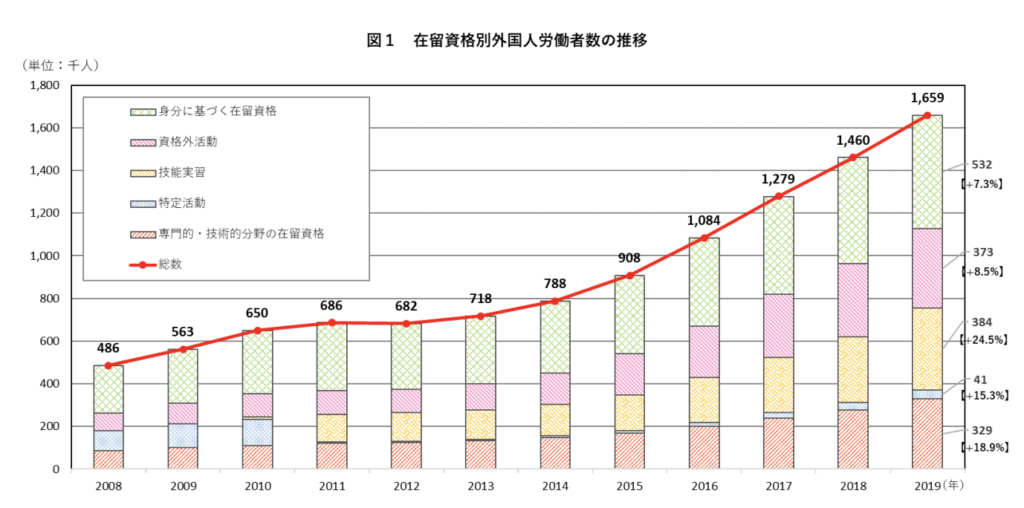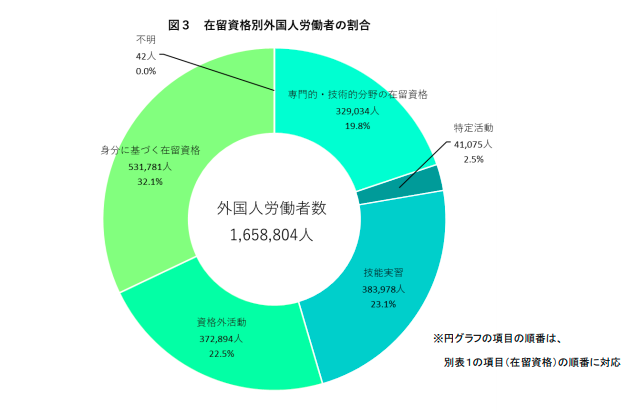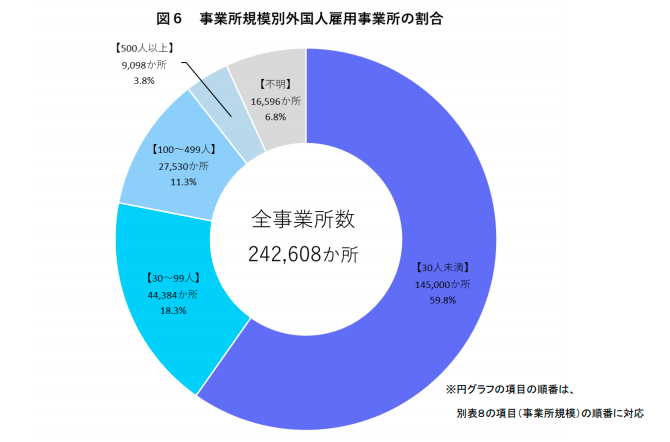For the last few years, the number of foreign workers has been steadily rising all throughout Japan, especially in big cities. This includes foreign students working part-time jobs as well as people who’ve moved to Japan for work. In this article, we’ll discuss the state of foreign workers in Japan by looking at publicly-available data mixed with facts about the country’s social landscape. We hope that this analysis proves useful to anyone currently working or hoping to one day work in Japan.
Japan Can’t Do Without Foreign Labor (and Other Facts About the Rapidly-Changing Country)

Japan is currently experiencing a declining population due to its low birth rate. It’s estimated that by 2030, one-third of the country’s population will be over 65 years old, resulting in a serious workforce shortage. Adding to that, the increased global competitiveness brought on by rapid globalization can spell big trouble for Japan unless the government focuses on the promotion of foreign labor.
That’s why the revision to the Immigration Control and Refugee Recognition Law (April 2019) introduced new residency visas: “Specified Skilled Worker (i)″ and “Specified Skilled Worker (ii).” They are meant to help out 14 domestic Japanese industries that have been having trouble with staffing and which require specific skills, although not necessarily the most advanced or technical ones. This allows foreign workers to be a part of the Japanese manufacturing and service industries.
However, this still doesn’t address the mountain of problems surrounding foreign labor in Japan: the complexity of applying for a work visa necessary for working in Japan, shady business owners hiring foreigners for dishonestly low wages, trouble arising from cultural/value clashes, and so on.
Then there is the issue of upcoming international events in Japan, like the 2021 Tokyo Olympics (although its status is uncertain due to the coronavirus pandemic) or the Osaka World Expo 2025. Besides increased globalization efforts by the Japanese government and businesses, these events will also heighten the demand for foreign labor, which itself will require new legislation to help make Japan a welcoming environment to overseas workers.
Now that we’ve covered the country’s social landscape, let’s look at some hard numbers to better understand the state of foreign workers in Japan.
How Many Foreign Workers Are There in Japan?
According to the Ministry of Health, Labour and Welfare’s Report on the Employment Situation of Foreigners (October 2019), there are 1,658,804 foreign workers in Japan, a 13.6% increase (198,341 people) over the previous year and the highest number ever recorded since 2007, when the reports became mandatory. This is most likely the result of the influx of foreign students and interns to the government’s Highly-Skilled Foreign Professionals Program and the Technical Intern Training Program. In recent years, some local governments have even started programs for people hoping to work in Japan, which should soon start yielding results.

* 2: “Residence Qualification Based on Skill or Expertise” (red bars) covers people staying long-term in Japan for work, and includes managers, technicians, researchers, chefs, specialists, etc.
* 3: “Residence Qualification Based on Status” (light green) covers statuses and stations authorized for long-term stay in Japan, including permanent residents, Japanese diaspora, etc.
* 4: “Designated Activities” (light blue) covers activities by foreign workers that have been authorized by the Minister of Justice on an individual basis.
* 5: “Activity Other than Permitted” (pink) covers activities outside the scope specified by the status of residence (limiting them to 28 hours a week), and includes foreign students working part-time jobs, etc.
Additionally, when foreign students (including those in undergraduate, postgraduate, junior college, and vocational institutions) finish school, 14,493 of them stay in Japan for work, representing about 31.1% of all graduates, according to data from 2016. This number has been going up each year, which seems to be the result of the Ministry of Education, Culture, Sports, Science and Technology’s support of foreign students joining the workforce.

Red striped bars: Those who stay in Japan for work. Data is fiscal 2009-2016
Percentage of Foreign Higher-Education Graduates Going into the Japanese Workforce (2016)
| Total | Postgraduate School (Ph.D.) | Postgraduate School (Masters) | Undergraduate School (College) | Junior College | Vocational School |
| 31.1% | 19.4% | 34.2% | 41.8% | 49.2% | 28.0% |
Breakdown of the Above Data:
Undergraduate/Postgraduate Schools: 8,610 people out of 23,946 (36.0%)
Junior Colleges: 221 people out of 449 (49.2%)
Vocational Schools: 5,532 people out of 19,727 (28.0%)
In order to remain innovative and competitive in the age of globalization, Japan has been taking steps to secure foreign workers and students for years now. Going forward, we can expect more multifaceted efforts from the country to support their foreign workforce.
Where Do Japan’s Foreign Workers Come From and What Are Their Visa Statuses?
1) Country of Origin
Nationality-wise, the plurality of Japan’s foreign workers are Chinese, making up 25.2% of the country’s foreign workforce (418,327 people). Following that we have the Vietnamese at 401,326 (24.2%) and Filipinos at 179,685 (10.8%). The biggest increase when compared to the previous year are Vietnamese workers, showing an increase of 84,486 people (+26.7%), Indonesians with an increase of 9,751 people (+23.4%), and the Nepalese with an increase of 10,208 people (+12.5%). As you can see, due to geographical proximity, the majority of Japan’s foreign workers hail from Asia.

2) Visa Statuses
Based on visa status, the majority of foreign workers in Japan (32.1%) are either permanent residents or the Japanese diaspora, falling under the “Residence Qualification Based on Status 1.” They’re followed by “Technical Intern Training” visa recipients at 23.1%, “Activity Other than Permitted” visa recipients (including foreign students) at 22.5%, and “Residence Qualification Based on Skill or Expertise” visa recipients at 19.8%.
Regarding trends, the 383,978 “Technical Intern Training” visa recipients had an increase of 75,489 (+24.5%) over the previous year. Similarly, the “Residence Qualification Based on Skill or Expertise” visa recipients (329,034 people) showed a noticeable increase of 52,264 (+18.9%).
The Technical Intern Training program helps foreigners enter Japanese companies so that they can work while acquiring skills and knowledge that will allow them to assist in the development of their home countries. In recent years, Japan has tried to make this system more accessible, with legislation like the Technical Intern Training Law or the revision of Immigration Control and Refugee Recognition Law.

Where in Japan Do Most Foreigners Work?
The three areas of Japan with the highest numbers of foreign workers are Tokyo (485,345 people, 29.3%), Aichi (175,119, 10.6%), and Osaka (105,379, 6.4%). Unsurprisingly, the top spots are taken up by the country’s major urban areas. On the other hand, if we look at growth rate, then the top three Japanese areas are Nara (5,563, an increase of 35.2% over the previous year), Okinawa (10,314, an increase of 26.7%), and Aomori (3,901, an increase of 24.4%).
When we compare the top 10 spots around Japan in terms of the number of foreign workers and the growth rate of the foreign workforce, we see absolutely no overlap whatsoever. This means that places where there already are many foreign workers don’t really change that much while places with relatively few foreign workers are continuing to grow. If this trend continues, foreign workers will soon become a fact of life throughout Japan. So, if you ever thought about working somewhere outside big Japanese cities, now is your chance.

Which Industries Do Most Foreigners Work In?
What kinds of jobs bring people to Japan?
The three industries most popular among foreign workers are Manufacturing (20.4%), Sales & Retail (17.4%), and Accommodations & Food Service (14.2%). Growth-wise, the number of foreigners working in Manufacturing has actually decreased by 1.0% when compared to the previous year, with Accommodations & Food Service experiencing a 0.3% reduction. On the other hand, the number of foreigners working in Sales & Retail has gone up by 0.4%, with Construction experiencing a 1.3% growth.
Looking at specific jobs, Japan has seen an increase in restaurant and convenience store workers as well as people joining the IT field (such as engineers) and the nursing care profession. And, of course, native English speakers working as foreign language teachers has long been a very popular occupation in Japan.

What Kind of Companies Do Most Foreigners Work At?
Looking at the sizes of companies that most foreigners in Japan join, the majority of them (59.8%) employ less than 30 people. But no matter how big the companies hiring foreigners are, their numbers keep growing, especially the ones with less than 30 employees, the number of which has grown by 14.0% since last year (the biggest increase out of them all).
After the revision of the law concerning the hiring of foreigners, more and more businesses, from corporations to small shops, have started expanding their staff this way.

Summary

The number of foreign workers in Japan keeps growing every year, and the government keeps revising laws in order to accommodate that. Even native Japanese people have gotten used to the idea that, like Japan’s national rugby team, it’s pretty great to share your culture and values with people of different nationalities.
If you’re interested even a little bit in working in Japan, we urge you to just go for it. You’ll get to interact with different people and cultures and will gain so much from the experience. There are so many Japanese industries just waiting for you with open arms. If you decide to take the plunge, we hope that tsunagu Local will continue to help you out during your new life in Japan.
References
- Ministry of Health, Labour and Welfare’s Report on the Employment Situation of Foreigners (October 2019): https://www.mhlw.go.jp/stf/newpage_09109.html
- About encouraging employment among foreign students in Japan: https://www.jetro.go.jp/ext_images/jetro/activities/support/ryugakusei/pdf/report_20190228/9.pdf
If you want to give feedback on any of our articles, you have an idea that you’d really like to see come to life, or you just have a question on Japan, hit us up on our Facebook!
The information in this article is accurate at the time of publication.

